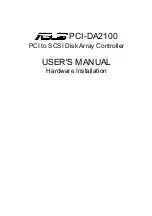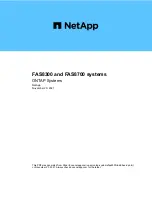
ASUS PCI-DA2100 User’s Manual
7
4. Disk Failure Management
One of the most important aspects of a RAID system is in providing fault-tolerant
non-stop disk storage operation. In the event of a disk failure, disk access will
continue normally with the failure transparent to the host system. The ASUS PCI-
DA2100 will announce a disk failure with a repeated two-beep sequence over the
speaker on the ASUS PCI-DA2100.
IMPORTANT: Although the RAID subsystem will continue to
provide uninterrupted disk access after a drive failure, do not leave a failed
drive unattended! Without a spare drive, a RAID system can not survive the
failure of a second drive on the same logical drive. A defective drive has to be
replaced and the data rebuild as soon as possible. For the same reason, if you
are doing hot-swapping, remove only the defective drive. Removing the wrong
drive will result in unrecoverable data loss.
In all cases, data will have to be rebuilt onto the replacement drive. Data rebuilding
is done in the background, meaning the host system can access the storage sub-
system as usual while the rebuilding is taking place.
4.1.
Operation With Spare Drive
Following are guidelines with regards to disk failure recovery when a spare drive is
available:
•
If a spare drive exists in the same logical drive, the controller will
automatically mount the spare drive and start data rebuilding in the background.
•
Depending on the design of the subsystem external to the ASUS PCI-DA2100,
it may be possible to remove defective drive and replace it with a new drive
without shutting down the system (hot-swapping). Alternatively, the system
can be shut down at a convenient time and the failed drive replaced.
•
The replacement drive must then be assigned as the new spare drive.
4. Disk Failure Management
4. Disk Failure
Management














































